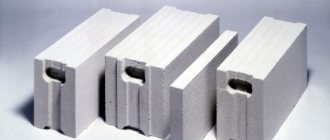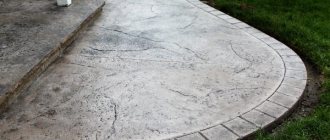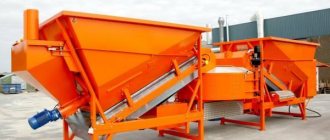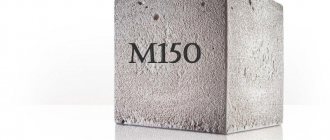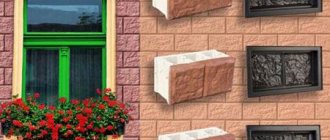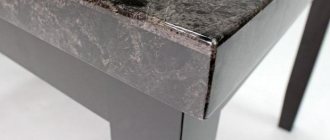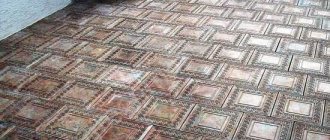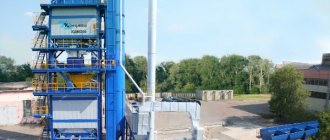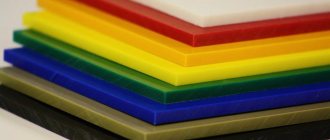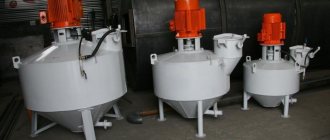Business benefits
This particular building material has been the most popular for many years, because it is the easiest to use and ideal in price. By drawing up a business plan for a concrete plant, you can be convinced of its quick payback, since this production does not require serious investments, and a stable income will be guaranteed for more than one generation. The thing is that there is no building material yet that would surpass concrete in all its quality and price indicators.
In addition to the standard composition and appearance of concrete pavement, today there are many more varieties of decorative mixtures. This gives reason to think about drawing up a business plan for a concrete plant. This mixture differs from the usual composition not only in many color options, but also in the addition of new components that increase the strength of the material and its resistance to external influences.
Degree of production automation
Concrete production differs in the degree of automation. Chemical additives and cement can be supplied either manually or using various delivery means - skip feed and others.
For example, RBU-2G-15B is equipped with a skip system for feeding bulk materials, which significantly speeds up the production process. The cost of this model is 650 thousand rubles.
Various actions can be performed both with the help of human muscular power (closing the gates) and with the use of pneumatics. Elkon products especially stand out from the rest.
At the request of the customer, the products can be equipped with a variety of options. For example, the Quick Master 35 model, which delivers about 25 m3 of concrete per hour, can be equipped with the following automation options:
- control panel manufactured by Siemens , which allows you to program the plant to perform certain actions. Also included in this kit is a Dell printer;
- dosing sensors for chemical additives, aggregates, cement.
These devices allow you to monitor and regulate the content of certain additives in the solution.
Some manufacturers equip their mobile mini-concrete plants with the ability to control via the Internet, which allows you to program work without leaving your home.
Also, a plant’s automated control system can often be integrated with various accounting programs, such as 1C Accounting.
Type of mixer that concrete plants can be equipped with Different concrete plants can be equipped with mixers of very different designs:
- planetary rotary mixer;
- rotary mixer;
- planetary mixer;
- plate mixer.
Most often you can find rotary and planetary mixers, as well as their combined varieties. They consist of an engine that transmits rotation to the working surfaces - blades (their number can vary from two to ten).
Such a mixer is present in the RBU-2G-15B design.
More interesting and unusual is the plate-type mixer. They are equipped with some plant models produced by Elkon.
The advantage of this type of mixer is that its design allows for more intensive mixing of concrete due to shortening the travel paths.
The working surfaces are blades, placed some distance from the center of the plate using special curved rods. The Quick Master 35 plant is equipped with such a concrete mixer.
Advantages of colored concrete
Decorative concrete coating can be used for finishing buildings as an independent mixture or as a material for casting other secondary coatings, for example, artificial stone. The production of concrete in these cases is no different from each other.
All products made from colored concrete mixtures are superior to standard compositions not only in their presentable appearance, but also in:
- strength indicators;
- long service life;
- increased sound insulation;
- environmental friendliness
The latter is due to the fact that the finished mixture does not release into the atmosphere any fumes harmful to humans or the environment.
Depending on the scale of production, such a business can be created as a mobile concrete plant or its branch to provide customers from other areas and regions with faster delivery of the product. Separately from the main production, you can organize your own sales points for decorative or artificial stone of your own production, since this finishing material for garden plots and interior decoration of residential premises is becoming increasingly popular. And its cost is quite reasonable.
Concrete production technology
Concrete used in construction in accordance with the regulatory document - GOST 25192 is classified according to grades, classes and its characteristics. In this business plan, we will consider only the important and useful information necessary for the production of concrete mix.
Raw materials
To prepare a classic solution, the following raw materials are needed:
- Cement is a binder that is the basis of a concrete mixture. It is a gray powder that crystallizes and hardens when moistened.
- Construction sand. According to GOST 8736-93, sand is a bulk material, the grain size of which should not exceed 0.5 mm.
- Crushed stone is a mineral with grains larger than 5 mm, produced by crushing gravel, rocks or slag.
- Ballast is a mixture of gravel and sand. A mixture with a ratio of 1:3 (one part river sand to three fine gravel chips) is best suited for concrete production. This composition is sometimes referred to as the "General Mixture".
- Water. For the production of concrete mixture, only clean water without foreign inclusions is used. There are no clearly established standards for water consumption, since its costs are determined by the moisture content of other raw materials.
Concrete production includes the following stages:
Preparation of raw materials
Typically, operations for the preparation of raw materials - removal of contaminants, crushing of aggregates - are carried out at enterprises that supply them for sale. At a concrete production plant, only special activities are carried out (preparing chemical additives, grinding cement, heating aggregates) when the need arises. Since the implementation of these operations entails additional costs for paying for utilities and purchasing special equipment. These operations include: the production of solutions of chemical additives, grinding cement, heating aggregates in the cold season.
Let's take a closer look at each of the events:
- preparation of chemical additives is the process of dissolving additives in clean water and then setting a certain concentration of the solution. To perform this procedure, containers with a pipeline system are used, which are designed to mix solutions of chemical additives using compressed air.
- Cement grinding can be done using wet or dry methods. Thanks to this operation, it is possible to speed up the hardening process of the final material - concrete. However, activation (grinding) of cement is not always carried out, since this requires additional energy costs and the presence of special equipment.
- Heating of aggregates is carried out in special bunkers or covered warehouses.
The heating stage of aggregates can be carried out using one of two methods:
- Passing hot air, steam or gas through the filler. This method is more economical, but to implement it it is necessary to take measures aimed at reducing steam losses;
- Contact heating method using combs and steam pipes, which are placed in bunkers.
Dosing the mixture
Dosing – measuring the consumption of raw materials for mixing a concrete mixture.
Typically, factories use weighing dispensers, thanks to which it is possible to measure the consumption of cement and water with a minimum error. If concrete production is carried out in the field, then volumetric dispensers are used for measuring. During this operation, the moisture content of the constituent components, especially sand, must be taken into account.
Mixing
The cement and aggregates are thoroughly mixed until a homogeneous mass is obtained. Depending on the characteristics and type of concrete mixture, various mixing methods are used. If the concrete mixture includes coarse-grained mobile mixtures with aggregate made of hard and dense rocks, then it is advisable to use gravity concrete mixing plants.
In such equipment, mixing is carried out as a result of repeated dropping and lifting of materials from a given height during rotation of the mixing drum.
Mixing of lightweight concrete and fine-grained mixtures is carried out in forced-action concrete mixing equipment. In this equipment, a homogeneous mass is obtained by mixing materials using blades and other devices. Sometimes enterprises perform vibration mixing. This method ensures the activation of cement, which has a positive effect on the strength of concrete.
The quality of this process directly depends on the duration. Insufficient duration of this operation can lead to deterioration of the properties of the concrete mixture.
Initial Investment
To open your own concrete plant, the price of which in working order is several million, you will need money in the amount of no more than half a million rubles. Taking into account such low costs and a high degree of return on investment, it is best to start this business from scratch by drawing up a detailed business plan for a concrete plant.
Having a starting amount of half a million rubles in hand, you should also think about the need to support production for the first few months from your own savings, and not from profit, since it may not be in the required quantity from the moment of opening. To do this, it is necessary to make approximate calculations of monthly expenses for the purchase of materials for production, payment of utility bills, rent of premises and wages to workers. The average amount is 250 thousand rubles.
Overall dimensions, difficulties of transportation and assembly
Despite the fact that their sizes are quite impressive.
Therefore, some difficulties may sometimes arise during transportation. But most manufacturers try to design their products in such a way that they take up a minimum amount of space when assembled.
Most often, a mini-plant can be placed in one or two trucks, which can be transported by one tractor. However, transportation is not so simple.
Also, sometimes difficulties arise during the installation process. Some plants require a special foundation to install a concrete production plant. For example, these are models from Elkon.
The RBU-2G-15B mini-concrete plant can be simply placed on a flat and hard surface. VNV 25 is equipped from the factory with a special platform on which it must be installed. This makes installation a simple and hassle-free process.
Selecting a room
Since even a mobile concrete plant needs a roof over its head, the first step is to decide on the choice of premises for production. For minimum cost-effective production volumes, a minimum of 70 square meters of usable space is required, and the premises themselves should ideally be located away from the city center. This will mainly affect the reduced rental cost, which, depending on the region, can be a maximum of 70 thousand rubles per month. In addition, production can cause discomfort to residents of nearby houses, so it is better to immediately provide free space around the plant.
No matter how correct the business plan for a concrete plant, high profits are ensured by a convenient location. To do this, the plant premises must be located near the roadway and have convenient parking and access. For the comfort of workers and the quality of future products, the building must be equipped with good ventilation and a heating system.
How to create a program?
A business plan for a concrete plant is a document that describes the goals of the enterprise, contains information about the manufacturer, future grades of concrete, intended sales markets, financial costs and profits. The document is drawn up and implemented only once, and then business development programs are established. The business plan includes the following points:
The document program must contain all the necessary data on the basis of which the enterprise will operate and generate income.
- Basic provisions. It is necessary to briefly describe the focus and main objectives of the enterprise, income and expenses, the possibility of fulfilling the plan, lending, repayment of borrowed funds, prospects.
- Target. The point includes the actual creation of the enterprise, as well as the target audience to which the manufactured product is directed - construction companies, private buyers.
- Finance. The entrepreneur pays all the expected costs of paying for the rent of the premises, wages, equipment costs, and the purchase of building materials from which concrete is made - cement, sand, crushed stone, water.
- Room. You should understand in advance which building layout is most suitable for the implementation of the project, since there must be space for a warehouse, heating, administrative offices, electricity and sewerage.
- Equipment. In this paragraph, you should clearly indicate what devices will be needed for concrete production (modules, loaders, augers, dispensers, mixers).
Costs for purchasing equipment
Even when choosing a business for the production of colored concrete, you will not need to purchase many production machines.
Among the major investments, you should highlight the need to purchase:
- concrete mixers;
- vibrating table;
- shelving;
- industrial and household floor scales;
- molds for filling finished products.
These equipment costs will be approximately 130-140 thousand rubles. The most money will be needed to purchase molds, since you will need at least 50 of them. You also need a lot of racks, 60 of them, but they cost half as much as the molds. A vibrating table, scales and a concrete mixer are needed in single quantities, but for this you need to choose equipment with a volume of at least 250 liters (for a concrete mixer).
Business plan for a concrete production plant
A building material production plant must include the following divisions:
- Cement warehouse;
- Aggregate warehouse;
- Boiler room;
- Administrative and utility plant;
- Support service block.
Premises for these units will be built. It is planned that the company will produce the following products:
- Heavy concrete (M 250) – annual production volume – 360,000 m3;
- Heavy concrete (M 350) – annual production volume – 640,000 m3.
Total – 1,000,000 m3.
Capital expenditures
Costs for construction and installation work (construction and installation work) – 280,786,000 rubles;
Equipment costs – 1,997,740 rubles;
Other costs – 20,315,500 rubles;
Total: 303,099,240 rubles.
Costs of raw materials and supplies
The need for raw materials and materials is established based on the consumption rates of these components per unit of production or annual production volume.
To produce an annual volume of concrete M 250, the following raw material costs are required:
1. To produce the annual volume of concrete M-250:
- cement – 13,860,000 tons;
- crushed stone – 28800 m3;
- sand – 16500 m3.
2. To produce the annual volume of concrete M-350:
- cement – 26880000 tons;
- crushed stone – 48,000 m3;
- sand – 28,800 m3.
Let's calculate the cost of purchasing raw materials:
1. For the production of concrete M-250:
- for cement: 138,600 tons * 2,800 rubles = 388,080,000 rubles.
- for crushed stone: 28800 m3 * 900 rubles = 25,920,000 rubles.
- for sand: 16,500 m3 * 500 rubles = 8,250,000 rubles.
2. For the production of concrete M-350:
- for cement: 26,880 tons * 3,000 rubles = 80,640,000 rubles.
- for crushed stone: 48,000 m3 * 700 rubles = 33,600,000 rubles.
- for sand: 28800 m3 * 600 rubles = 17,280,000 rubles.
Total: 553,770,000 rubles.
Payroll costs
To start a concrete production plant, the following personnel are required:
- administrative and managerial staff – 5 people;
- for the concrete mixing shop – 9 workers;
- for a cement warehouse - 12 workers;
- for the aggregates warehouse – 9 workers;
- for the support services block – 10 workers;
- drivers – 4 workers;
The total number of workers at the plant is 49.
The annual payroll includes the following expense items:
- salary of administrative and managerial personnel – 4,800,000 rubles;
- salary for concrete mixing shop workers – 4,320,000 rubles;
- salary for workers at a cement warehouse – 4,320,000 rubles;
- salary of workers at the aggregates warehouse – 3,240,000 rubles;
- salary of workers for the support services block – 2,400,000 rubles;
- salary for drivers – 960,000 rubles.
Total: 20,040,000 rubles.
Other costs
Advertising costs in the media and the Internet (per year) – 97,500 rubles per year.
Indirect costs (per year) – 250,000 rubles per year.
Costs for maintenance and operation of equipment (per year) – 186,679,000 rubles;
Shop costs (per year) – 800,000,000 rubles.
General plant costs – 825,000,000 rubles.
Total costs (per year) – 2,385,836,500 rubles per year.
Revenue
Revenue for the year (sales of concrete):
- heavy concrete (M-250) – 360,000 m3 * 3900 rubles = 1,404,000,000 rubles.
- heavy concrete (M-350) – 640,000 m3 * 4,100 rubles = 2,624,000,000 rubles.
Total: 4,028,000,000 rubles.
Annual revenue excluding VAT – 3,302,960,000 rubles.
Calculation of technical and economic indicators:
Net profit – 917,123,500 rubles.
Production profitability is 38%.
Payback period - 303,099,240/917,123,500 =0.33 years or about 4 months.
Raw material costs
To implement the business plan of a concrete production plant, you will also need to purchase raw materials. Since all the ingredients of the mixture are publicly available, there can be no problems at this stage. Considering the large discounts from sellers when purchasing large quantities of materials and free shipping, you can save a decent amount.
To start making colored concrete mix you will need to purchase:
- river sand;
- cement;
- granite screening;
- plasticizers;
- dyes.
Of course, all ingredients, except pigment, must be purchased in tons, and the costs here depend on the volume of purchases and the cost of materials in the region.
Business plan Rifey Beton 25
The need for a general contractor to have his own concrete production plant is not a whim these days, but a necessity. Being independent from outside supplies is very convenient and cost-effective. A concrete plant is a unit with a very short payback period, which has high productivity and a relatively low price. This calculation was created to clearly show the profitability of the Rifey Beton 25 concrete plant.
The business plan uses a concrete production recipe, M100, in reality the number of such recipes can be 150. Prices for raw materials are relevant for the southern Urals, as of February 2020:
| Name | Weight, kg | Price in rubles, per 1 kg |
| Cement M400 D20 | 250 | 4 |
| Crushed stone | 1120 | 0,4 |
| Sand | 795 | 0,25 |
| Water | 190 | 0,02 |
To understand how quickly a project will pay off, you first need to understand how much to invest in it. Here are the main expenses for a concrete plant, even before its launch. This includes prices for RBU and cement silos, which are not included in the base cost of the plant. Delivery and commissioning costs are based on transportation within the Ural Federal District. If necessary, items can be added.
| Concrete plant Rifey Beton 25 | 2260000 |
| Cement silo 20 tons | 280000 |
| Construction of the foundation | 28000 |
| Equipment delivery | 100000 |
| Commissioning works | 89000 |
| Tools, workwear, etc. | 70000 |
| Total costs | 2827000 |
For the normal functioning of the RBU, we will need maintenance personnel (operator, mechanic), and engineers (foreman, foreman, accountant). The director's salary is not reflected in the calculations.
| Number of workers, including foreman and production manager | 6 |
| Work schedule, in hours | 8 |
| Working days per month | 22 |
| Average salary in production | 25000 |
| Electricity consumption per month, with an installation power of 37 kW | 6512 |
| Cost kW per hour | 3,53 |
Having data on the cost of raw materials, equipment, and labor costs, we can calculate the cost of one cubic meter of concrete produced:
| Expense item | Quantity required to produce 1m3 | cost, rubles |
| Cement | 250 | 1000,00 |
| Crushed stone | 1120 | 448,00 |
| Sand | 795 | 198,75 |
| Water | 190 | 3,80 |
| Salary | 45,45 | |
| Electricity, kW per hour | 2,47 | 8,71 |
| Cost of 1 m3 of concrete | 1704,71 | |
| Taking into account total costs (for depreciation, taxes, special equipment + 15%) | 1960,42 |
Having the market value of concrete, we can calculate how much profit the launch of production at BRU will bring:
| Cost of 1 m3 of concrete in Zlatoust, in rubles | 2500 |
| Productivity Rifey-Beton-25, m3 per shift | 150 |
| Revenue from production per shift, in rubles | 375000 |
We calculate the profit and payback of Rifey Beton 25
| Profit from production 1m3, in rubles | 539,58 |
| Profit per shift, in rubles | 80937,20 |
| Number of shifts before return on investment | 35 |
| Payback of the project in months | 1,6 |
Thus, calculations show that a concrete plant, with its load throughout the entire working day, is subject to continuous operation. The equipment pays for itself in just a month and a half!
The calculation of a business plan is simplified, and it does not contain such items as advertising and expenses for registering an enterprise. The calculation was created to show how much profit can be obtained from one concrete plant.
Current expenses
In addition to a one-time investment in the business, you will need to pay monthly bills for electricity, water supply, sewerage, garbage collection, heating, and so on. As a rule, for production scales this amount fluctuates around 15 thousand rubles.
In addition, workers will need to be paid wages. Among them there must be a qualified accountant, a foreman or foreman and ordinary workers. In this case, the amount depends on the region chosen for the business.
Hiring employees
Since the productivity of a plant does not depend on raw materials, but on the work of employees, hiring personnel should be taken seriously. Workers must be experienced or at least easily trained, responsible and hardworking.
In order for an inexperienced citizen to obtain a license to open a production facility, he, like his employees, should undergo a special training course. This will allow you to learn more about the nuances of producing high-quality products, obtain technical documentation, permission to work in this area and all the basic formulas for the production of colored concrete.
To determine the required number of employees, it is worth knowing that in one work shift, three workers are able to efficiently produce approximately 40 cubic meters of the final product.
Spread of information
So, it’s clear how to open a concrete plant, but how to attract customers? First of all, advertising campaigns should be organized throughout the city and region so that as many potential buyers as possible learn about the opening of a new enterprise. You can use newspapers, radio, television, placing posters on billboards, and so on. For wider distribution among the population, you can place your contact information with the logo and business name on office supplies or business cards placed in retail grocery stores.
Working with clients
In addition to extensive advertising activities, the owner of a new business should take care of material evidence of his advantage over clients. To do this, you should prepare ready-made samples of your products in advance so that customers can immediately appreciate all the advantages of the finished material made of colored concrete. Examples of your work should be posted at all planned distribution points, and separately for each option. In the future, you can also create a portfolio of photographs of your products in customers’ finished interiors, so that potential buyers can appreciate all the advantages of the material immediately in use.
In order to always release current products, a business owner should not get hung up on the first versions of his products; it is important to constantly improve and surprise customers with new ideas. To do this, you can attend special construction materials fairs or regularly take advanced training courses. Starting a business is not so difficult, it is much more difficult to keep it afloat and still make good money.
Business plan for a mobile concrete plant
* The calculations use average data for Russia
PROJECT SUMMARY
The project involves organizing the production of asphalt concrete mixtures based on a mobile concrete plant in Stavropol. The company also provides installation services. The target audience of the project is private customers engaged in landscaping, management companies of the housing and communal services complex, homeowners' associations, gardening associations, industrial organizations, etc. Thus, the project is not focused on large-scale road construction, but on servicing small orders on its own. It is planned to purchase a mobile asphalt concrete plant (China) that was used but in good condition with a capacity of 10 t/hour and an asphalt mini-roller (Russia).
The advantage of a mobile asphalt concrete plant is the ability to move it to a construction site, which significantly reduces logistics and time costs for delivering the mixture from a stationary asphalt concrete plant. The mini-roller has a drum width of 780 mm, which allows you to work with it even in hard-to-reach places - narrow passages, alleys, garden paths, etc.
Table 1. Project performance indicators
| № | Index | Meaning |
| 1 | Revenue 1 year, thousand rubles. | 54 020 |
| 2 | Net profit for 1 year, thousand rubles. | 20 530 |
| 3 | Revenue in subsequent years, thousand rubles. | 62 117 |
| 4 | Net profit of subsequent years, thousand rubles. | 23 871 |
| 5 | Net profit for 5 years, thousand rubles. | 121 211 063 |
| 6 | NPV, thousand rubles | 9 885 |
| 7 | IRR, % | 20,23 |
| 8 | ARR, % | 29,4 |
| 9 | P.I. | 1,43 |
DESCRIPTION OF THE COMPANY AND INDUSTRY
The project's activities are essentially related to measures to improve territories, financed by both the state and private investors. Against the background of a decrease in the volume of construction of residential and commercial real estate, the volume of renovation and improvement work is growing.
In particular, the municipal subprogram “Road activities and ensuring road safety, organizing transport services for the population in the city of Stavropol” of the program “Development of housing and communal services, transport system in the city of Stavropol, improvement and sanitary cleaning of the territory of the city of Stavropol for 2014-2016 " supposed:
- design, construction and reconstruction of public roads of local importance;
- repair of public roads of local importance, including sidewalks;
- accounting of public roads of local importance;
- provision of elements for the development of public roads of local importance and organization of road safety, including road signs, road barriers, traffic lights and other devices for traffic control, stopping points, pedestrian paths, etc.;
- maintenance of public highways of local importance;
- repair and maintenance of intra-block public roads of local importance, including sidewalks, storm sewers, entrances to intra-block territories
- purchasing equipment for cleaning roads and sidewalks;
- ensuring the activities of the municipal budgetary institution “Unified Central Dispatch Service of Passenger Transport” of the city of Stavropol;
- carrying out passenger transportation by urban electric transport at tariffs below the established maximum tariff level for the transportation of passengers by urban electric transport (trolleybuses) along routes in the city of Stavropol.
Thus, it is envisaged to carry out a number of activities in which the goods and services of the project can be used. In addition, an analysis of each of the target audiences shows significant prospects for the development of the project.
Stavropol is the administrative center of the Stavropol Territory of the Russian Federation. A cultural, business and industrial center, one of the largest cities in the North Caucasus and the North Caucasus Federal District. Large enterprises of the machine-building and instrument-making industries are located on the territory of the city. According to the results of the All-Russian competition for the title of “The most comfortable urban (rural) settlement in Russia” (2013, 2020 and 2020), Stavropol took first place, which indicates the high attention on the part of the Administration to the state of improvement of the territories of the city and the region. The city is located on the federal highway P216 Stavropol - Elista - Astrakhan and P269 Stavropol - Bataysk.
The project involves the organization of an enterprise for the production and laying of asphalt concrete mixtures in the city of Stavropol and the Stavropol Territory. Acquired production capacities – a used mobile asphalt concrete plant made in China, with a capacity of 10 t/hour and a mini-double-drum roller made in Russia; In addition, hand tools are purchased for unloading the mixture, laying it and leveling it.
Consumers of the enterprise's goods and services are various categories of legal entities and individuals, non-profit organizations. The level of demand for the company's goods and services is assessed as high.
DESCRIPTION OF GOODS AND SERVICES
The company's products are asphalt concrete mixtures for various road works and landscaping work. Asphalt concrete is a building material produced by creating a mixture of a binder (bitumen, cement) and filling elements (crushed stone, sand) and then cooling it. Depending on the laying temperature, asphalt concrete mixtures are divided into hot, warm and cold. Depending on the physical properties, asphalt concrete is divided into rigid, plastic and cast.
Table 2. Products of the enterprise and their description
| № | Name | Description |
| 1 | Coarse asphalt concrete | Asphalt concrete mixture is dense or porous, based on bitumen. Grain size up to 40 mm. For major road construction and repairs |
| 2 | Fine-grained asphalt concrete | Asphalt concrete mixture of various densities based on bitumen. Grain size up to 20 mm. For major road construction and repairs |
| 3 | Sand asphalt concrete | Asphalt concrete mixture of various densities based on bitumen. Grain size up to 5 mm. For the construction of pedestrian paths, sidewalks |
The mixture is made to order according to customer specifications. All products comply with GOST requirements. It is assumed that the customer will pick up the products from the production area.
In addition, the company provides services for laying asphalt concrete mixtures at construction sites. For this, an asphalt mini-roller with a drum width of 780 mm is used, which allows you to work in hard-to-reach and narrow places.
Table 3. Variable costs and selling price
| PRODUCT/SERVICE | COSTS PER UNIT, rub. | TRADE MARKUP, % | UNIT COST, rub. | |
| 1 | Coarse-grained asphalt concrete, t | 930 | 130% | 2 139 |
| 2 | Fine-grained asphalt concrete, t | 970 | 130% | 2 231 |
| 3 | Sand asphalt concrete, t | 1 000 | 130% | 2 300 |
| 4 | Vibratory roller rental, hour | 120 | 1200% | 1 560 |
| Total: | 8 230 ₽ |
SALES AND MARKETING
The target audience of the project is diverse. These include, first of all:
- Municipal improvement organizations
- Private repair and improvement enterprises
- Gardening partnerships
- Enterprises in the sphere of housing and communal services (management companies, homeowners associations)
- Road construction enterprises
- Private customers
To interact with organizations, an active sales technique is used: sales representatives conduct negotiations with all types of potential clients to conclude an agreement to perform work on the installation of asphalt concrete pavement. Some orders, especially those with government funding, take place in the form of auctions and tenders. The sales policy of the project is focused on building long-term partnerships, increasing customer loyalty through reasonable prices, strict adherence to deadlines and conditions of work.
Work with private customers is carried out through passive sales: using your own website, various electronic and printed catalogs of building materials, aggregators of goods and services. This area is supervised by an Internet promotion specialist who also accepts applications from individuals and processes them.
Demand has a pronounced seasonality and generally coincides with the course of the construction season. The maximum level of demand occurs in the warm months; in winter there is practically no demand. Taking into account the climate characteristics of the Stavropol Territory, we can talk about full demand from April to October, as well as single orders in March and November in good weather. The seasonality factor is taken into account when planning sales, drawing up production and financial plans.
The price level for the project's asphalt concrete mixtures is approximately 5% lower than the market average. There is competition in this segment, however, almost all existing competitors have stationary asphalt concrete plants and are focused primarily on large-scale road construction. Stationary asphalt plants are characterized by low flexibility, higher logistics costs and higher operating costs compared to mobile asphalt plants. Their only advantage can be considered high productivity, which determines the direction of the sales policy.
Today, there are three mobile asphalt concrete plants operating in the region, two of which are in unsatisfactory condition, which causes problems with the stability of the quality of the mixture produced. The price level for goods and services is on average 5-7% higher than the project prices.
Table 4. Planned sales volumes
| T PRODUCT/SERVICE | AVERAGE PLANNED SALES VOLUME, units/month. | PRICE PER UNIT, rub. | REVENUE, rub. | VARIABLE COSTS, rub. | |
| 1 | Coarse-grained asphalt concrete, t | 1 700 | 2 139 | 3 636 300 | 1 581 000 |
| 2 | Fine-grained asphalt concrete, t | 1 200 | 2 231 | 2 677 200 | 1 164 000 |
| 3 | Sand asphalt concrete, t | 1 550 | 2 300 | 3 565 000 | 1 550 000 |
| 4 | Vibratory roller rental, hour | 90 | 1 560 | 140 400 | 10 800 |
| Total: | 10 018 900 | 4 305 800 |
PRODUCTION PLAN
For the production of asphalt concrete mixture, a purchased mobile asphalt concrete plant, used in use, is used. Country of origin: China. The condition is very good, important components and assemblies have been replaced with new ones. Productivity – up to 10 t/hour. The ability to produce various types of asphalt concrete - from coarse-grained to high-density sand. Delivery from the location to Stavropol is carried out by the project using special transport and is financially included in the cost of the equipment. Setting up, debugging the technology and training personnel is carried out by a technologist who is part of the initial project team and has many years of experience working at asphalt plants.
To lay the mixture, a used Russian-made mini-skating rink is used. Condition – good. Delivery from the seller is carried out by special transport at the expense of the project, the cost of transportation is also included in the financial plan. Equipment is stored in an open area rented from an industrial complex in Stavropol. For the winter, equipment undergoes a conservation procedure and is covered with moisture-proof materials.
Upon receipt of an order, the mobile asphalt plant moves directly to the work site. Transportation costs are included in production (variable) costs. The asphalt concrete mixture is produced on site, laid and leveled by workers manually, and then compacted using a mini-roller. At the final stage, tests of the hardened coating are carried out.
Since sales are project-based in nature, the production plan completely coincides with the project sales plan.
ORGANIZATIONAL PLAN
The chosen organizational and legal form is individual entrepreneur. The taxation system is the simplified tax system, the object of taxation is “income minus expenses”, the rate is 15%.
The project team at the initial stage includes:
- a project initiator who has more than five years of experience in running his own construction business and has all the necessary knowledge in the field of entrepreneurship, accounting and tax accounting, labor and administrative legislation, etc.
- technologist with experience in various positions in the production of asphalt concrete and cement concrete mixtures, including as a technologist - 4 years.
Thanks to the experience of the team, it is possible to fulfill the key requirements for the project: ensuring sales and product quality.
Despite the experience and high competence of the existing project team, high demands are placed on the sales department employees directly involved in interaction with the company’s customers. Basic requirement: at least three years of sales experience in the building materials industry; It is desirable to have a personal car.
Table 5. Staffing and wage fund
| Job title | Salary, rub. | Number, persons | Payroll, rub. | ||
| Administrative | |||||
| 1 | Accountant | 23 000 | 1 | 23 000 | |
| Industrial | |||||
| 2 | Technologist/production manager | 30 000 | 1 | 30 000 | |
| 3 | Line Operator | 23 500 | 1 | 23 500 | |
| 4 | Helper workers | 20 000 | 3 | 60 000 | |
| 5 | Vibratory roller operator | 22 000 | 1 | 22 000 | |
| Trade | |||||
| 6 | Sales Representative | 25 000 | 2 | 50 000 | |
| 7 | Internet promotion specialist | 23 000 | 1 | 23 000 | |
| Total: | 231 500.00 ₽ | ||||
| Social Security contributions: | 69 450.00 ₽ | ||||
| Total with deductions: | 300 950.00 ₽ | ||||
Figure 1. Organizational structure of the enterprise
Preparatory work for the project, including the purchase of equipment, personnel selection, initial negotiations with potential clients, etc. last no more than one month. After this, the stage of mass production and reaching planned sales volumes begins.
FINANCIAL PLAN
The project is not limited in time, since the demand for the products and services of the project, according to expert estimates, will not fall in the future. The financial plan has a planning horizon of five years, which seems to be the most suitable period for planning.
The financial plan takes into account all income and expenses of the project. Income refers to revenue from the operating activities of the project; income from investment and sale of fixed assets is not provided for by the project.
Investment costs are 6.83 million rubles, the bulk of the amount is aimed at purchasing equipment and creating a working capital fund until the enterprise reaches payback. The project initiator’s own funds are 4.5 million rubles, the lack of funds is planned to be covered by attracting a bank loan for a period of 24 months, the rate is 18% per annum. Payment is made in annuity payments, credit holidays are three months.
Table 6. Investment costs
| NAME | AMOUNT, rub. | |
| Equipment | ||
| 1 | Mobile asphalt plant | 5 000 000 |
| 2 | Vibratory roller | 710 000 |
| 3 | Hand tool | 160 000 |
| 4 | Office equipment | 150 000 |
| Intangible assets | ||
| 5 | Website development | 60 000 |
| Working capital | ||
| 6 | Working capital | 840 000 |
| Total: | 6 920 000 ₽ | |
| Own funds: | 4 500 000.00 ₽ | |
| Required borrowings: | 2 420 000 ₽ | |
| Bid: | 18.00% | |
| Duration, months: | 24 | |
Variable costs (Table 3) include costs for the purchase of raw materials and supplies used in production, fuel and lubricants for equipment, and transportation of equipment to the construction site.
The volume of fixed costs is 115,666 rubles. per month, of which the bulk is allocated to depreciation charges. In this project, depreciation is not included in production costs due to the rather complex calculation of deductions per unit of production. When determining the amount of monthly depreciation charges, the linear method is used; the useful life of fixed assets and intangible assets is ten years.
A detailed financial plan is given in Appendix. 1.
Table 7. Fixed costs
| NAME | AMOUNT PER MONTH, rub. | |
| 1 | Office rental | 15 000 |
| 2 | Parking area rental | 3 500 |
| 3 | 30 000 | |
| 4 | Fuel and lubricants and transport | 7 000 |
| 5 | Communication and Internet | 1 500 |
| 6 | Business expenses | 5 000 |
| 7 | Administrative expenses | 3 000 |
| 8 | Depreciation | 50 666 |
| Total: | 115 666 ₽ |
EFFICIENCY MARK
The effectiveness and investment attractiveness of the project is assessed based on an analysis of the financial plan, simple and integral performance indicators.
To account for changes in the value of money over time, the discounted cash flow method is used. Discount rate – 10%. Revenue of the first year of the project – 54,020,060 rubles; net profit (after taxes) – 20,529,669 rubles. Annual revenue for subsequent years (after achieving sales targets) – 62,117,180 rubles; net profit – 23,870,643 rubles. Simple (PP) and discounted (DPP) payback period is 6 months. Net present value (NPV) – 9,884,999 rubles. Internal rate of return (IRR) – 20.23%. Return on Investment Ratio (ARR) – 29.4%. Profitability index (PI) – 1.43. All these indicators are high and indicate the high investment attractiveness and effectiveness of the project.
GUARANTEES AND RISKS
When analyzing the risks associated with the implementation of the project, an analysis of internal and external factors is carried out. The main internal risk factor is the failure of equipment, primarily asphalt plants, and, as a consequence, downtime and loss of profit. To neutralize this threat, it is necessary to constantly monitor the condition of the equipment, its ongoing maintenance and repair. Much attention must be paid to the preservation and re-preservation of equipment: follow the technology, carry out maintenance and cleaning of all components and assemblies. Careful and attentive treatment of equipment is a guarantee of project success.
External factors include the actions of competitors: price reductions, the emergence of new players in the market. The latter option is quite unlikely given the economic downturn in the country. Price competition from existing players is much more likely. The pricing policy and pricing system of the project allows such a fight to be carried out quite effectively; there is a margin for profitability and marginality. In addition, measures are provided to increase customer loyalty through higher quality of service, compliance with deadlines and other conditions for performing work.
APPLICATIONS
Annex 1
Financial plan
Denis Miroshnichenko
(c) www.openbusiness.ru – portal of business plans and guides for starting a small business
Source
